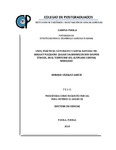| dc.contributor.author | Vázquez García, Adriana | |
| dc.creator | VAZQUEZ GARCIA, ADRIANA; 374232 | |
| dc.date.accessioned | 2018-10-29T17:18:58Z | |
| dc.date.available | 2018-10-29T17:18:58Z | |
| dc.date.issued | 2018-08 | |
| dc.identifier.uri | http://hdl.handle.net/10521/3040 | |
| dc.description | Tesis (Doctorado en Ciencias, especialista en Estrategias para el Desarrollo Agrícola Regional).- Colegio de Postgraduados, 2018. | es_MX |
| dc.description.abstract | Desde hace cientos de años los magueyes pulqueros (Agave salmiana) representan un modo y medio de vida para habitantes de la altiplanicie central mexicana. Tomando como referente las visiones étnicas, mestiza e indígena, se realizó un análisis comparativo de su situación actual en seis municipios pertenecientes a los estados de Tlaxcala e Hidalgo. Se trató de un estudio de corte cualitativo que recurrió a la etnografía y a las entrevistas estructuradas como métodos de investigación. La información registrada se presenta en tres artículos, los dos primeros contemplan aspectos culturales-económicos del maguey y el último el capital natural que lo explica. Los principales resultados muestran al agave pulquero como una planta multifuncional y polifacética. Convenientemente se propusieron los términos: maguey entero, maguey capado, maguey saltado, usos de primer orden, usos de segundo y tercer orden. De las más de 20 formas de destino listadas, existe un conjunto de representaciones sociales entorno al cultivo-aprovechamiento para la elaboración de pulque, mismas que difieren en expresión entre grupos culturales. El capital natural de los magueyes concede un valor asociado con su multifuncionalidad y capacidad de supervivencia. La calidad y cantidad como recurso se ha visto amenazada, las causas son distintas y se hayan ligadas al contexto geográfico, histórico y sociocultural de cada lugar; razón por la cual es pertinente plantear una estrategia de conservación desde la visión de patrimonio. _______________ USES, CULTURAL PRACTICES AND NATURAL CAPITAL OF THE MAGUEY PULQUERO (AGAVE SALMIANA) IN TWO ETHNIC GROUPS, IN THE TERRITORY OF THE MEXICAN CENTRAL HIGHLANDS. ABSTRACT: For hundreds of years the pulque magueys (Agave salmiana) represent a livelihood and way of life for inhabitants of the Mexican central highlands. Considering the ethnic, mestizo and indigenous visions, a comparative analysis of its current situation was carried out in six municipalities belonging to the states of Tlaxcala and Hidalgo. The qualitative study that used ethnography and structured interviews as research methods. The registered information was presented in three articles, the first two contemplate cultural-economic aspects of the maguey and the last one the natural capital that explains it. The main results show the agave pulquero as a multifunctional and multifaceted plant. Conveniently, the terms proposed were: entire maguey, castrated maguey, leapt maguey, first order use, second order use and third order use. Of the more than 20 listed forms of destiny listed, there is a set of social representations around the cultivation-use for the elaboration of pulque, which differ in expression between cultural groups. The natural capital of the magueyes grants a value associated with its multifunctionality and ability to survive. Quality and quantity as a resource have been threatened, the causes are different and have been linked to the geographic, historical and sociocultural context of each place; which it is why it is pertinent to propose a conservation strategy based on the heritage vision. | es_MX |
| dc.description.sponsorship | Consejo Nacional de Ciencia y Tecnología (CONACyT). | es_MX |
| dc.format | pdf | es_MX |
| dc.language.iso | spa | es_MX |
| dc.rights.uri | http://creativecommons.org/licenses/by-nc-nd/4.0 | es_MX |
| dc.subject | Labores culturales | es_MX |
| dc.subject | Maguey pulquero | es_MX |
| dc.subject | Multifuncionalidad | es_MX |
| dc.subject | Servicios ecosistémicos | es_MX |
| dc.subject | Cultural works | es_MX |
| dc.subject | Multifunctionality | es_MX |
| dc.subject | Ecosystem services | es_MX |
| dc.subject | Estrategias para el Desarrollo Agrícola Regional | es_MX |
| dc.subject | EDAR | es_MX |
| dc.subject | Doctorado | es_MX |
| dc.subject.classification | CIENCIAS SOCIALES::SOCIOLOGÍA::GRUPOS SOCIALES::TRIBUS | es_MX |
| dc.title | Usos, prácticas culturales y capital natural del maguey pulquero (Agave salmiana) en dos grupos étnicos, en el territoriao del altiplano central mexicano. | es_MX |
| dc.type | Tesis | es_MX |
| Tesis.contributor.advisor | Estrella Chulím, Néstor Gabriel | |
| Tesis.contributor.advisor | Aliphat Fernández, Mario Manuel | |
| Tesis.contributor.advisor | Ortiz Torres, Enrique | |
| Tesis.contributor.advisor | Ramírez Juárez, Javier | |
| Tesis.contributor.advisor | María-Ramírez, Andrés | |
| Tesis.date.submitted | 2018 | |
| Tesis.date.accesioned | 2018 | |
| Tesis.date.available | 2018 | |
| Tesis.format.mimetype | pdf | es_MX |
| Tesis.format.extent | 2,422 KB | es_MX |
| Tesis.subject.nal | Agave salmiana | es_MX |
| Tesis.subject.nal | Nacionalidades y grupos étnicos | es_MX |
| Tesis.subject.nal | Nationalities and ethnic groups | es_MX |
| Tesis.subject.nal | Pueblos indígenas | es_MX |
| Tesis.subject.nal | Indigenous peoples | es_MX |
| Tesis.subject.nal | Hidalgo, México | es_MX |
| Tesis.subject.nal | Tlaxcala, México | es_MX |
| Tesis.rights | Acceso abierto | es_MX |
| Articulos.subject.classification | Maguey | es_MX |
| dc.type.conacyt | doctoralThesis | es_MX |
| dc.identificator | 5||63||6309||630908 | es_MX |
| dc.contributor.director | ESTRELLA CHULIM, NESTOR GABRIEL; 223554 | |
| dc.audience | generalPublic | es_MX |


